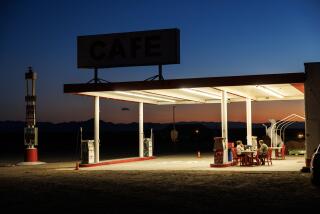Hidden passion under the hood
- Share via
The Driver
My Dangerous Pursuit of Speed and Truth in the Outlaw Racing World
Alexander Roy
HarperEntertainment: 326 pp., $25.95
--
Alexander ROY was speeding onto Santa Monica Pier in his blue BMW M5 in the early hours of Oct. 9, 2006, more than 2,700 miles behind him and less than a minute short of his goal: crossing the country in less than 31 hours and seven minutes to break a 23-year-old record.
Then he spotted the police cruiser.
The 35-year-old cross-country racer was wanted by traffic cops nationwide. He’d racked up dozens of moving violations, jammed his cars with pricey radar detectors and even posed as a German traffic cop, all in the interest of breaking transcontinental driving records set more than 20 years ago in the underground races immortalized by the 1981 Burt Reynolds film “Cannonball Run.”
But at that moment on the pier, Roy remembered a glitch that could foil everything: One of his headlights was out.
“Police officers waited their whole careers for traffic stops like this,” Roy writes in his breathless, adrenaline rush of a memoir, “The Driver: My Dangerous Pursuit of Speed and Truth in the Outlaw Racing World.”
Nearly blind with exhaustion, Roy writes, he slowed, sweated and strained to act nonchalant, barely glancing to his side as the Santa Monica cop, a K-9 unit officer, approached and then passed him.
Go ahead -- call Alex Roy spoiled, self-centered and indulgent. Challenge his outlaw cred and titles. Then turn the page.
It’s an over-the-top account. But that befits the racing world Roy inhabits, a world where the king of Morocco suspends all traffic laws for the duration of a 48-hour race, where winners risk death for a metal bust of Burt Reynolds and where drivers blow $20,000, as Roy did, on cross-country record attempts. He made it to the end of Santa Monica Pier with three minutes to spare, averaging 90.1 mph only by reaching 150 mph at times and risking the lives of fellow drivers, pedestrians and police.
But this is more than a testosterone cocktail of a memoir. It’s a joy ride of pithy observations, as Roy opens up the shiny veneer of the outlaw racing world and probes the dirty ethical dilemmas under the hood. He admits that his racing strained friendships, alienated girlfriends and even cost him time with his ailing father.
“I became blind to everything beyond what was necessary to reach the summit,” Roy writes. “Nothing and no one was spared.”
This raises the question that Roy, to his credit, attempts to answer: Was high-stakes racing worth it?
Roy begins by casting himself as the epic hero -- albeit a spoiled, New York City private-school-educated one with a hefty bank account and automotive prowess thanks to his father’s European car dealership.
It was his father who sparked Roy’s interest in outlaw racing during a hospital visit in 2000. As the elder Roy lay dying of cancer, he revealed to his son that he’d participated in Cannonball races in his youth but failed to break the 32-hour barrier. He recalled his chief rival only as “the driver.” Soon after, Roy decided to find that rival and beat the cross-country record.
This device -- Roy’s ongoing quest to meet the driver -- feels a bit contrived, particularly for an outlaw who scoffs at speed limits and traffic patrols. But it doesn’t slow an otherwise fast-paced story, propelled by such colorful rivals as redneck Texas racer Richard Rawlings in his souped-up Chevy Avalanche or Eyhab, the Middle Eastern tycoon tooling around in a Lamborghini Murcielago, accompanied by his entourage.
Roy casts himself as the middle-class oddball of the pack, particularly after the family car dealership hits the skids after the Sept. 11 terrorist attacks. His tightened finances wouldn’t have mattered as much in his father’s day, when outlaw races were seat-of-the-pants enterprises involving amateur drivers with second jobs. But today’s racers have corporate sponsors or trust funds and pit teams to enable their expensive hobby. As Roy notes, it costs at least $8,000 just to register with the underground organizers of the modern-day Cannonball Run, Bullrun and Gumball races.
At times, Roy taps wealthy sponsors like Vegas Mike, who loans him a yellow Lamborghini only to see Roy crash it into a wall. Mostly Roy compensates for his limited budget by racing the favorite of German traffic cops, the BMW M5, which is considered austere by outlaw racing standards. Roy says he chose it because it’s fast, fuel-efficient and low-profile. But it also dovetails with his racing alter ego: the German polizei, or police officer.
Roy wore vintage German police uniforms (bought online and pictured in the book) and outfitted his car with polizei stickers and lights, the better to confuse police and opponents -- and win entry to the “private private private after parties” in Miami Beach, Marrakech and the Playboy Mansion in Los Angeles.
As Roy traces his transcontinental exploits to the present day, it becomes clear that he’s not trying to beat his father’s long-lost rival or even claim his father’s legacy. He needs to leave his own mark on the world by winning the race.
Roy admits that outlaw racing took its toll, financially and emotionally. As he writes at book’s end, he was shaken this year when fellow racers crashed into a nonracing car during the Gumball 2007 race in Macedonia, killing two passersby. He now talks about staging legal races with a higher purpose and he’s seeking a sponsor for a cross-country race in fuel-efficient hybrid cars.
And yes, he says, it was all worth it.
--
molly.hennessy-fiske@latimes .com
More to Read
Go beyond the scoreboard
Get the latest on L.A.'s teams in the daily Sports Report newsletter.
You may occasionally receive promotional content from the Los Angeles Times.










